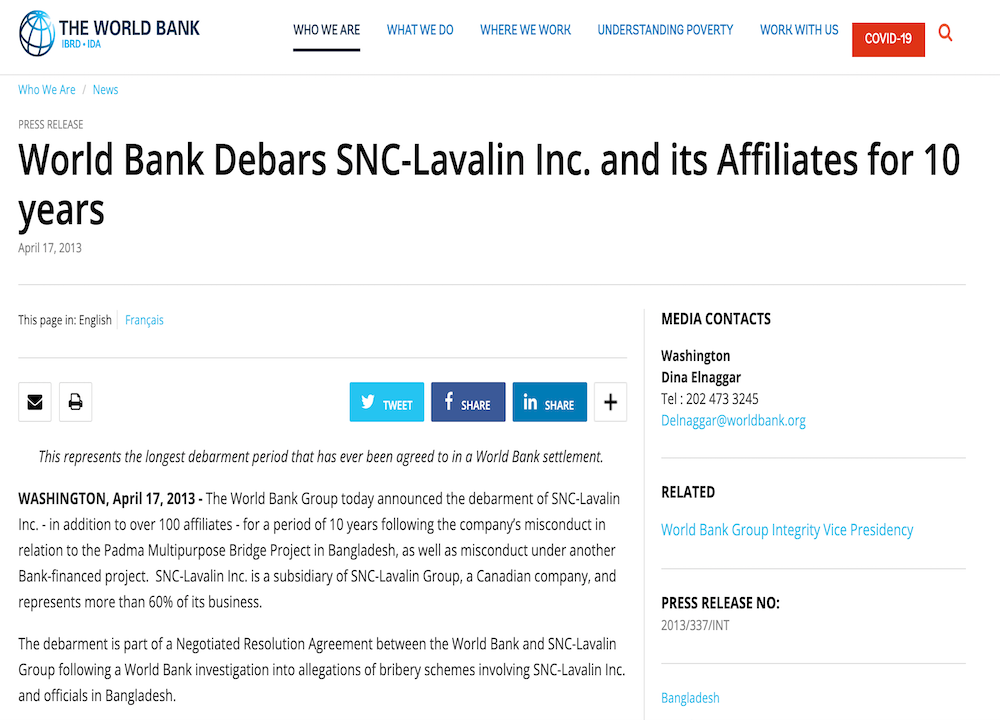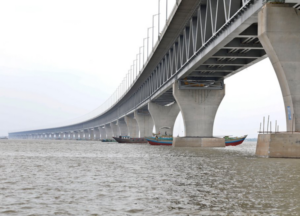Bangladesh government’s extraordinary campaign to deny the Padma bridge corruption conspiracy ignores an admission by SNC Lavalin that it sought to bribe government officials.
The scandal, which was uncovered by the World Bank, involved the Canadian company SNC Lavalin which was seeking to bribe Bangladesh government officials so that it received a $50 million contract to supervise construction on the bridge. In its press release about the cancellation, the World Bank stated: “The World Bank has credible evidence corroborated by a variety of sources which points to a high-level corruption conspiracy among Bangladeshi government officials, SNC Lavalin executives, and private individuals in connection with the Padma multipurpose bridge project.”
Bangladesh government wants to replace this with a contrived narrative about how there was in fact no corruption, and that people instead have conspired against the government to falsely accuse its officials of involvement in corruption and to blacken the country’s name.
The prime minister, including in parliament, has in recent days repeatedly spoken about, a conspiracy against the state — indeed, as Netra News has already reported, seeking to scapegoat, among others, the founder of Grameen Bank Muhammad Yunus. Accommodating newspapers are publishing or republishing polemical, partisan and wholly inaccurate articles supporting the government’s position. And just a few days ago, Bangladesh’s High Court ruled that a commission of inquiry should be set up to “identify the conspirators” who worked against Bangladesh.
There are a number of notable aspects about the government’s attempt to replace established facts for its fake narrative.
Company’s admission of culpability
In all the remarks made by Prime Minister Sheikh Hasina, echoed by her followers and set out in the articles written by pro-government columnists, there is a crucial and determinative fact that they never mention. That in April 2013, the Canadian company SNC Lavalin admitted to the World Bank that it was involved in a “conspiracy to pay bribes” to Bangladesh government officials in its attempt to win a Padma bridge contract.
We know this because the Canadian company did not contest the allegations against it but agreed to a “Negotiated Resolution Agreement” with the World Bank which resulted in the debarment of SNC-Lavalin Inc and over 100 of its affiliates for a period of 10 years. To get the benefits of a negotiated settlement SNC Lavalin had to admit its “culpability” in seeking to pay bribes to government officials and agree to cooperate with the World Bank’s investigation.
A World Bank spokesperson confirmed this to Netra News, “All INT settlements require the settling company to acknowledge engaging in a sanctionable practice under World Bank rules; and to commit to cooperating with INT,” INT refers to the World Banks’s “Integrity Vice Presidency”, which undertakes investigations into alleged corruption.
The press release on the World Bank website, dated April 17th 2013, states the following:
“The World Bank Group today announced the debarment of SNC-Lavalin Inc. — in addition to over 100 affiliates — for a period of 10 years following the company’s misconduct in relation to the Padma Multipurpose Bridge Project in Bangladesh…
The debarment is part of a Negotiated Resolution Agreement between the World Bank and SNC-Lavalin Group following a World Bank investigation into allegations of bribery schemes involving SNC-Lavalin Inc. and officials in Bangladesh…
SNC-Lavalin’s misconduct involved a conspiracy to pay bribes and misrepresentations when bidding for bank-financed contracts in violation of the World Bank’s procurement guidelines. Under the agreement, the SNC-Lavalin Group and its affiliates commit to cooperating with the World Bank’s Integrity Vice Presidency and continuing to improve their internal compliance program.

Indeed, we know from the February 2013 report of the External Panel of Experts, set up by the World Bank, that the company provided World Bank investigators — as part of this negotiated settlement — with documents relating to the bribery scheme. The “company agreed to provide relevant documents to the Integrity Vice-Presidency”, the report says. We do not know exactly what was the nature of this documentation, though it appears the World Bank obtained email correspondence between company officials and Bangladesh government officials (see below). It is often the case that when INT first contacts a company about alleged corruption, the company undertakes its own internal inquiry report, and SNC Lavalin may well have provided this report to the World Bank investigators, along with details of incriminating emails.

The press release noted that the 10 year period of debarment represented “the longest debarment period that has ever been agreed to in a World Bank settlement”. This indicates the seriousness of the corruption the company had admitted.
So, one has to ask this. How, prime minister, could there be a conspiracy against Bangladesh involving conspirators trying to blacken Bangladesh’s name with supposedly false allegations of corruption, when the company, at the centre of the allegations, formally admitted to seeking to bribe Bangladesh government officials?
Are the Sheikh Hasina, the columnists and all those echoing their arguments somehow expecting us to believe that SNC Lavalin admitted to a conspiracy to bribe Bangladesh government officials — accepting ten years debarment of the company and its subsidiaries — when the allegations of corruption against it were actually not true?
SNC Lavalin is no longer on World Bank’s debarment list as it was able to reduce the ten year sanction to eight years by complying “with all conditions of the agreement.” The settlement agreement is, however, not a public document.
Bangladesh’s Anti-Corruption Commission
Another key point entirely left out of the “conspiracy against the state” narrative made by government and its supporters is the fact that there was a time when Bangladesh’s Anti-corruption Commission’s own inquiries accepted that SNC Lavalin was involved in a conspiracy to bribe government officials. The letter of the World Bank’s Expert Panel of Expert which was sent to the ACC on January 9th 2013, and leaked to the media, noted the following:
“[T]he sequence of events considered by the panel and now established by the ACC suggests a criminal conspiracy that includes former Minister Hossain as the most senior official personally involved. The ultimate award of the contract required his approval. He met with SNC Lavalin managers during a reunion requested by Secretary Bhuiyan to negotiate the illegal payment. As a consequence of the meeting his name and the indication of a payment of 4% was included in a list of people that were to receive a compensation for their alleged involvement in the conspiracy.” (emphasis added)
The panel’s letter also provides a great deal of evidence — including details of emails — to support the corruption conspiracy.
“The Panel considers that the following facts have a significant bearing for further investigation by the ACC:
a. During the procurement process two Bangladeshi public servants including Quazi Md. Ferdous (Member Secretary of the Evaluation Committee) divulged confidential information to SNC Lavalin’s managers in violation of their duties and requested further instructions or support from them. ACC rightly considers that they should be under investigation for their involvement in the conspiracy.
b. ACC also considers that Md. Mosharraf Hossain Bhuiyan, Secretary, Bridges Division and Executive Secretary Bangladesh Bridge Authority (BBA), was involved in the conspiracy. It should be noted that since June 23, 2010, Secretary Bhuiyan and Ferdous were members of the Evaluation Committee (for the technical and financial proposals).
c. During the procurement process Ismail Hossain, director of an SNC Lavalin subsidiary, represented the company. In the opinion of an SNC manager “the Secretary and the Minister” were dealing with him. On March 14, 2011, Ramesh Shah, Vice President of SNC Lavalin International was asking for the “PCC cost on the project in detail.” PCC is a euphemism used by SNC Lavalin to indicate the cost of the bribes to be paid.
d. The financial opening took place on March 28, 2011 and SNC Lavalin was placed second after Halcrow.
e. This result greatly concerned SNC Lavalin. Mohammad Ismail was trying to change the situation. On April 1, 2011, he was planning to meet with Ferdous in New York. However by a letter dated April 5, 2011, Ramesh Shah, Vice President of the SNC Lavalin International subsidiary notified the Bangladesh authorities that Mohammad Ismail was no longer working for the company.
f. On April 10, 2011, SNC Lavalin’s local consultant wrote a “confidential” email to Kevin Wallace, then Vice President and General Manager of SNC Lavalin: “Halcrow’s low bid has put us in second position. But, it is not over yet. A major forgery act has been detected in their proposal, and the client is considering re-verification of the Key Personnel’s CVs. SNCs CVs will also be verified; SNC will be receiving a letter from the client to that effect shortly”.
g. The local consultant added “The entire marketing effort was done by Ismail and myself. The client was very comfortable dealing with Ismail; that includes the Secretary and the Minister. However, after receiving the notice [of Ismail’s termination] they got very puzzled and are about to lose confidence on us. At this very critical stage we have to reestablish their confidence a.s.ap. As desired by the Secretary, you may have a conversation with him immediately. His name is Mosharraf Hossain Bhuiyan, cell +880171407xxxx. As mentioned to you earlier, the client will not accept Ramesh as the contact point because of previous experience and reputation.”
h. On April 12, 2011 one of the suspects, Quazi Ferdous of the BBA informed SNC Lavalin and Halcrow that the Evaluation Committee would be carrying out an evaluation of their proposals and requesting information about their personnel’s CVs.
i. On three different occasions the local consultant insisted that Secretary Bhuiyan was expecting a call from Wallace. He convinced Mr. Wallace of the need to visit Bangladesh “to seal” the project, indicating the interest of someone higher than Secretary Bhuiyan. The consultant wrote: “The top guy wants to meet/see a sada (white) Canadian” adding “Did you get a chance to talk to Mr. Bhuiyan?”
j. On May 29, 2011, Kevin Wallace and Ramesh Shah visited Bangladesh and met with Secretary Bhuiyan, and Minister Hossain. After the meeting Ramesh Shah wrote on a notepad under the heading “PADMA PCC.” “4% Min”; … “1% Secretary…”
k. A few days later, on June 13, 2011 the BBA submitted to the World Bank for non objection an Evaluation Report recommending that SNC Lavalin be awarded the CSC contract indicating “issues/concerns” regarding Halcrow’s financial and technical proposals.
l. On June 19, 2011 the SNC Lavalin managers recognized the privileged treatment that they received “BBA has already sent the final recommendation without our full compliance with the [CV] verification process.” And confirming the collusion with Mr. Ferdous: “[Even though BBA has sent the recommendation they still need [the verification] for their records. … Please try to arrange this otherwise Ferdous will be in trouble.”
How, one wonders does all this evidence fit into the Bangladesh government narrative?
The High Court decision
The High Court ruled on June 28th 2022 that the government must establish within 30 days a commission of inquiry to “identify the conspirators who have been spreading false news of corruption in Padma bridge project.” The High Court had earlier stated that those who have criticised the bridge construction were “enemies of the country” and “must be identified.” This decision to set up a commission to investigate a non-existent conspiracy against the state is yet further evidence of how the High Court has become totally suborned to the current Awami League Government and its political agenda.
Had the High Court undertaken any form of independent judicial enquiry and not simply relied on biased and partisan media reports that were the basis for this order, they would have found there was absolutely no need for a commission, since no “false news of corruption was spread”. Instead, as shown above by the evidence obtained by the World Bank and shared with the ACC, along with SNC Lavalin’s own admission of guilt, there was indeed a conspiracy to bribe Bangladesh government officials.
Let’s hope that someone actually sends this commission, if and when it is set up, a copy of the World Bank press release, the letter of the Panel of Experts and the initial First Information Report written by the ACC, so it does not waste any time in digging up a non-existent conspiracy against the government and the country.
Corruption in Bangladesh
The government’s claims that a government contract did not involve corruption no doubt appeals to a nationalist sentiment, but it is so counter intuitive to most Bangladeshis, that one wonders whether it will really persuade anyone.
This is because the government’s narrative cuts across what practically everyone in Bangladesh knows about systemic corruption in the country; how it exists in just about every government contract; how influential government connected “middle-men” are used to extract money from companies with the promise that this will help them get the contract; and how this results in the financial enrichment of key decision makers including ultimately many senior government ministers.
Ordinary people know about how this all works, even if they are not involved in seeking government contracts, because so many of them are forced to pay hundreds of thousands of takas (equating to thousands of dollars) simply to get their son, cousin, sister or brother the chance of a government job — whether it be for a basic position as a teacher, a police officer, or a soldier. People are well aware how this ritualised corruption results in key decision makers, including many senior government ministers, lining their own pockets.
So, it is unlikely that most people will really believe that there was “no corruption” in this one contract involving the Padma bridge. The only thing unusual here is that the attempted corruption was discovered, investigated and had repercussions.
The smokescreen
Those seeking to claim that there was no corruption in the Padma bridge procurement process focus on one thing, and one thing alone — and that is the acquittal in Canada in February 2017 of two former SNC Lavalin executives and a Bangladeshi Canadian businessman who had been criminally charged individually with corruption.
The acquittal followed a decision by a Canadian judge that wire-tap surveillance evidence obtained by Canadian police — that was crucial to the prosecution of the men — could not be used in a trial against them as an earlier judicial order to permit the wire-taps had not been properly given. As a result of this decision, the Canadian prosecutors decided that they could not proceed to trial. The acquittals were, it should be noted, not evidence based, but based on procedural failures. Who knows quite what would have happened if the wire-tap evidence had been allowed to be used in the trial?
However, even without a trial convicting these men, what is important about this decision, is that it does not take anything away from SNC Lavalin’s prior admission of culpability for involvement in a conspiracy to bribe Bangladesh government officials.
Pro-government columnists publishing in the Bangladeshi media have attempted to mislead people about the Canadian judge’s comments made in his decision about the initial “tipsters”. The “tipsters” are the people whose claims the Canadian authorities has used to obtain the initial permission to tap the communications of the accused. The judge said these tips amounted to “nothing more than speculation, gossip and rumour.”
As noted elsewhere, the columnists and government advocates completely misrepresent the nature of these tipsters — seeking to give the impression that their tips were all the evidence that the World Bank had prior to its decision to allege corruption and end its loan to the Bangladesh government. This is not the case. These were just the initial tips received by the World Bank in 2011, which triggered its own investigation. In March 2011, the World Bank passed this information to the Canadian police who then used the information to secure a warrant that allowed them to wire-tap individuals allegedly involved in the corruption, in real time.
Subsequent to receiving the information from the tipsters, the World Bank undertook its own investigations, which included obtaining documents (and apparently emails) from SNC Lavalin. The company in June 2013 admitted culpability in a conspiracy to bribe Bangladesh government officials. It was on the basis of this evidence — some of which is set out above — that led to the World Bank suspending its loan to the Bangladesh government and the company admitting its involvement in the conspiracy to corrupt Bangladesh government officials. The tipsters’ evidence by then was totally irrelevant, as the World Bank had by this time subsequently obtained actual evidence of the corruption conspiracy.
In fact, although the Canadian judge held that the information given by the tipsters was “nothing more than speculation, gossip and rumour” — and not sufficient to justify a warrant for surveillance — the evidence subsequently obtained by both (a) the investigation by the World Bank and (b) the evidence contained in the wire-taps (which could not be used in the trial) proved that the tipsters claims were completely correct.
Authoritarian governments are, we know, not dissuaded by facts. Indeed they try to make up new facts that support their own contentions. Let’s hope that the Bangladeshi people are not as easily persuadable by false claims as the current Awami League governments hopes that they are.●
David Bergman (@TheDavidBergman) — a journalist based in Britain — is Editor, English of Netra News. He also runs the bangladeshpolitico blog










